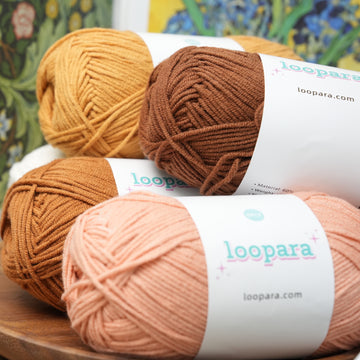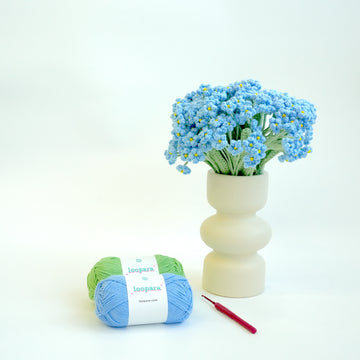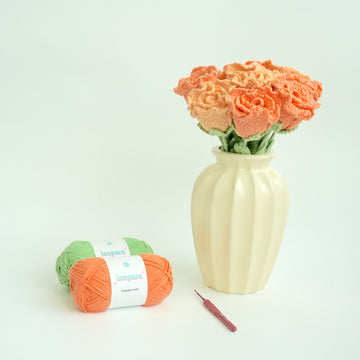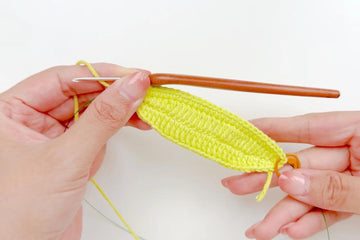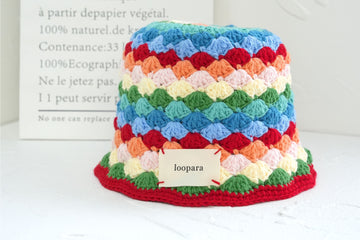If you’re embarking on a new hobby, it can help to get a sense of long it might take to master it. So just how long does it take to learn to crochet?
You might not be surprised to learn that there’s no simple answer to this! What one person finds simple might take someone else hours to get to grips with.
But the good news is, it’s possible to get a fair idea of the range of time you’re likely to need. We’ll look at how long you might need to set aside to learn the basics, then some more complicated techniques.
And we’ll share some hints and tips to help you on your crocheting journey.
1. Learning basic crochet stitches: 4 to 10 hours

When you first start learning to crochet, you’ll need to spend some time getting comfortable with the hook and yarn. You’ll probably try out different ways of holding the hook before you find one that works for you. And you’ll be learning how tightly to hold the yarn to get the right tension.
Of course, to do those things, you’ll need to be using the hook and yarn! The easiest stitch to start out with is the chain stitch, the foundation for most crochet pieces.
Chain stitch
Reading about how to complete a chain stitch suits some people. Others prefer watching someone else doing it. If that’s you, we have the YouTube video to help.
Whatever learning style works for you, you can start crocheting a chain stitch in just a few minutes, And if you like step by step tutorial with images, check out our guide here.
Other simple stitches
After that, you can try out some other simple stitches. Watch out here, because there are two different naming systems for crochet stitches, US and UK. And the same names can mean different things, depending on which system is being used.
If you’re using US terminology, the simplest stitches to start out with are the single and double crochet. In UK terminology, those equate to the double and treble crochet (there’s no such thing a single crochet stitch in UK crochet jargon).
So if you’re learning from videos, books or online tutorials, just make sure you know what terms they’re using. (And don’t be confused by a “half double” crochet! You’ll move onto this in the next stage. For now, all you need to know is that this isn’t the same thing as a “single”.)
Check out our free step by step stitch video tutorial: 44 different types of crochet stitches, from beginner to Advanced.
First projects
At this stage, you can make simple fabric swatches. Those can be any size you want.
As you get more comfortable with the stitches, you can make regular sized squares, also known as “granny squares”. These can be used to make bigger projects later, by stitching them together, such as granny square bag.

2. Mastering the basics and expanding your repertoire: 10 hours
Once you’ve got to grips with the chain stitch, single (or double) and double (or treble) crochets, you’re ready to learn more stitches.
A good next step is the US half-double (known as the half-treble in UK terminology) and the treble (or double-treble in UK lingo).
As with the stitches you’ve learned already, choose whatever resources you prefer to guide you.
At this stage, you’re probably starting to feel more comfortable with the hook and yarn. Give yourself plenty of time to get to grips with the new stitches. And keep practising your earlier stitches too, so you don’t forget what you’ve learned already.
Allow around ten hours for this stage of your learning journey. But if you find it takes longer to get to grips with all the stitches you’re learning, don’t worry. Just work at your own pace and stick with it. You’ll get there!
Beginner projects
Now you’ve got a range of simple stitches at your disposal, you can start to turn them into crocheted pieces.
Try out projects with simple shapes. Flower applique, Dishcloths, bookmarks and coasters all work well. You’ll have the satisfaction of creating something beautiful or useful (or both!) from scratch. And it will give your motivation a boost too.

3. Complex stitches and colorwork: 20 to 50 hours
At this stage, you’ve mastered all the basic crochet stitches and are comfortable producing simple pieces. Now it’s time to expand your repertoire to encompass more complex stitches like bobbles, shells and cabling.
This is also when you can start experimenting with color. Crocheting in different colors is known as “colorwork”, and it can be great fun. But it takes a bit of time to learn. As you practice, you’ll learn how to weave in different yarns and disguise the ends.
This is also a good time to start looking at patterns. Learn the different stitch abbreviations and get comfortable with interpreting diagrams.
It’s up to you how much time you want to spend learning new techniques. The more time you’re able to set aside, the further you’ll be able to go.
As a rough indication, about 20 hours of practice will be enough to give most people a good grounding in more complex stitches and colorwork. If you can put in 50 hours, you’ll also be able to experiment with textured stitches and more demanding patterns.
Intermediate projects
With these new skills at your disposal, you can work on projects that showcase different stitches, textures, colors and effects. Multicolored blankets, textured shawls, and amigurumi (toy animals) will all now be within reach of your expertise.

Check our free flower patterns
Crochet artistry and customizing patterns: 100+ hours
At this stage, you’re fast on the way to becoming a crochet master. There’s no real limit to the amount of time you can spend refining your skills. Continuing to practise will give you the confidence to raise your crochet to the highest level.
After 100 hours of advanced crocheting, you’ll be an expert at regulating tension and creating intricate designs. You’ll be able to choose just the right yarn for the most complex project, and the perfect hook too.
And you’ll be able not only to follow the most advanced pattern, but to adapt it to create a bespoke piece.
Advanced projects
Advanced projects will showcase your crochet flair with intricate patterns using color and texture. You’ll be able to confidently create your own pieces from scratch, or customize patterns to produce a unique result.
Six Pro Tips for learning crochet
If you’re ready to start learning crochet, here are some handy hints and tips to help you on your way.
1. Work with your learning style.
If you enjoy reading and poring over diagrams, there are lots of great crocheting books out there to help you learn. If you prefer to see someone in action, check out YouTube videos. And if you enjoy learning alongside others, find a local crocheting group. Choosing an approach you enjoy will make it both easier and more fun to learn – meaning you’re more likely to stick with it.
2. Don’t get too hung up on how long it’s taking.
The hours set out here are a good guide – but that’s all they are. If you can practise every day, you may find you make progress faster. If you can’t, it may take time to get back into the groove when you next pick up your hook. Don’t be deterred. The one thing that is certain is that you’ll get better if you persevere.
3. Take quick wins.
When you’re starting out, choose simple projects that give you the best chance of success. There’s nothing like the satisfaction of completing a crochet coaster or bookmark to motivate you to keep learning.
4. Sometimes it’s best to put the hook down.
If you’re having a day where nothing’s going right, it can help to take a breather and do something else. Keeping plugging away when you’re frustrated and cross risks you starting to associate crochet with those negative feelings. Do something else and come back to it when you’re ready.
5. Know that mistakes are part of the process.
All crocheters, no matter how experienced, have to unpick their work from time to time. This is known as “frogging” (because you “rip it, rip it”) – try to learn to love it! It’s a sign that you’re pushing yourself to do something new, and that you’re learning from it.
6. Ask for advice.
There’s a passionate community of crocheters out there who are only too happy to share their skills! Joining a local group is a great way to connect with others and share your expertise. But it’s also easy to interact online – from bloggers and YouTubers, to crocheting groups on social media. If you have a question, just reach out.
How long does it take to crochet? A quickfire summary
It’s not possible to give a precise timeline for the journey from crochet beginner to expert. But there are some broad guidelines to give you a sense of what might be ahead.
Once you’ve got your hook and yarn, you can get started with a simple chain stitch in just a few minutes. Mastering it, together with a couple more simple crochet stitches, can take anything from around four to ten hours of practice.
After about 20 hours, you’ll probably be able to move onto intermediary projects. That means learning more complicated stitches and colorwork.
To become an advanced crocheter is likely to take at least 100 hours of practice.
But there’s never any point at which you’ll stop learning. As long as you keep picking up that crochet hook, you’ll be developing new skills. That’s what makes crochet such a fun and rewarding pastime.


